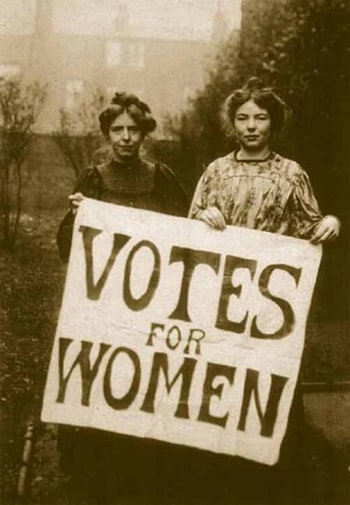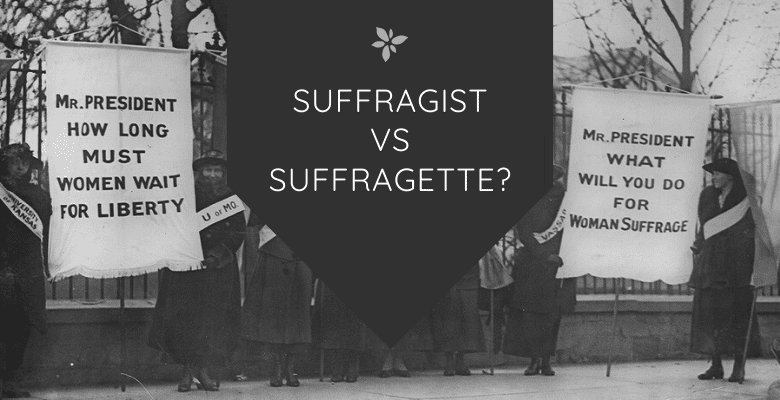Though the words “suffragist” and “suffragette” look like they’d mean the same thing, using them the same way could get you in trouble. When should you use which, and why could one be considered offensive? Read on to find out what the difference is between suffragist vs suffragette.
What did the suffragists stand for?
Suffrage means the right to vote in political elections, and a suffragist is a person who is part of a movement to gain the right to vote.
Though the word is often used in reference to the women’s suffrage movement, it can also refer to those who fought for black suffrage, Native American suffrage, or as a part of other suffrage movements.
The first known use of the term “suffragist” was in the early 19th century in regards to voting rights for free blacks in the United States. After the women’s suffrage movement picked up steam towards the end of the 19th century, the term was used more often in reference to women’s suffrage.
The suffrage movement in the United States mostly believed in getting the vote with nonviolent methods like protests, petitions, public meetings, and distributing literature. Even these methods were considered radical at the time for women, though, especially public speaking.

Many suffragists in the United States were temperance advocates (like Amelia Bloomer) and many were very religious, and were very much against violence.
However, there were some women who thought that they’d never get the vote just by arguing for it.
Some women believed they needed to take more extreme action to demand the vote.
What’s the definition of suffragette?
The word “suffragette” was coined by journalist Charles E. Hands in an article he wrote for the London Daily Mail in 1906. He used the diminutive ending “-ette” to mock and disparage the actions of militant suffragists such as Emmeline Pankhurst and the organization she founded, the Women’s Social and Political Union (WSPU).
The women of the WSPU gladly embraced the term, however, and started calling themselves “suffraGETtes” (with a hard “g”), proclaiming that they didn’t just want the vote, but would GET it.
What’s the difference between suffragist and suffragette?
In the United Kingdom, the epithet “suffragette” was reclaimed by militant suffragists, while more conservative organizations only used the term “suffragist.”
The media began to use the two terms to differentiate between the conservative suffragists led by Millicent Fawcett, and the militant suffragettes founded by Emmeline Pankhurst.
While some American suffragists also began using the label “suffragette” to reclaim it from their enemies, most American suffragists considered the term offensive and insulting.

Instead of protests and pamphlets, suffragettes used tactics like:
- smashing shop windows
- bombing public buildings
- burning homes, churches, restaurants, and railways
- cutting phone lines
- sending letter bombs
- chaining themselves to railings
- spitting at police and politicians
In one famous case, suffragist Mary Richardson became known as the “Slasher” after she attacked Diego Velazquez’s painting Rokeby Venus with a meat cleaver. Another suffragist, Mary Leigh, was arrested in 1912 for throwing a hatchet at the Prime Minister.
Christabel Pankhurst was also arrested several times, once for barging into a Liberal Party meeting and demanding the right to vote for women. She and many other suffragists went to prison after refusing to pay a fine.
Is “suffragette” offensive?
The word “suffragette” was coined as an offensive term to mock and belittle women who fought for equal rights. In modern English, the diminutive ending “-ette” is most often used to denote an imitation of the original, and often a poor imitation: The Oxford English Dictionary remarked in the case of “sermonette” that it “can scarcely be said to be in good use, though often met with in newspapers.”
Though there are no suffragists to protest its use today, historically it was considered by most suffragists in the United States to be an offensive term. Since about 1970 (around the time of the second wave of the women’s rights movement), “suffragist” has become the more common term in the United States, but “suffragette” is still used about half as much.
Suffragist vs Suffragette: Conclusion
Now you know the difference between suffragist vs suffragette in history, but what about today?
Throughout the history of the women’s rights movement, the only group of suffragists who reclaimed and proudly used the word “suffragette” were the militant suffrage organizations in the early-20th century United Kingdom, such as the WSPU.
Today the terms “suffragist” and “suffragette” are still used in the United Kingdom to differentiate between the women’s suffrage organizations based on the militancy of their tactics.
Next, read about Amelia Bloomer: Temperance, Suffrage, and Rational Dress Advocate, or learn about The Seneca Falls Convention: The Spark That Ignited the Suffrage Movement!
Keri is a blogger and digital marketing professional who founded Amazing Women In History in 2011.






Leave a Reply